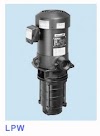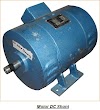Two Stroke Petrol Engine
Joseph Day & Son of Bath patented the first successful design of a three-port two-stroke engine in 1889. The underside of the piston was used in conjunction with a sealed crankcase to create a scavenge pump ('scavenging' refers to the pushing out of exhaust gas by the induction of fresh charge).
 |
| Fig. 1 Two-Stroke-Cycle Petrol Engine |
Crankcase-To-Cylinder Mixture Transfer
As the piston descends down the cylinder, the exhaust port (E) is first exposed, allowing the burnt exhaust gases to escape into the atmosphere. Simultaneously, the underside of the piston moves downward, compressing the previously filled mixture of air and atomised petrol in the crankcase.
Cylinder Compression and Crankcase Induction
The piston is moved in the direction of the cylinder head while the crankshaft revolves. The piston seals off the transfer port first, then closes the exhaust port fully after a short time. The mixture of air and atomised petrol will be compressed to around one-seventh to one-eighth of its initial volume as the piston continues to move inward.
Cylinder Combustion and Crankcase Compression
A spark plug in the cylinder head's center will be timed to spark and ignite the dense mixture just before the piston reaches the peak of its stroke. Under full load, the charge's burning rate will rapidly raise the gas pressure to a maximum of about 50 bar. The burning mixture expands, driving the piston back along its stroke and lowering cylinder pressure in the process.
The combined cycle of events adapted to a threecylinder engine is shown in Figure below show the complete cycle in terms of opening and closing events and cylinder volume and pressure changes respectively.
Sumber http://keluargasepuh86.blogspot.com










